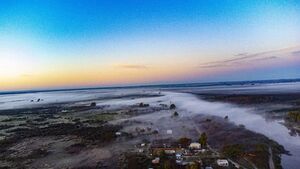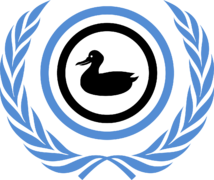Republic of Lomoria
Republic of Lomoria Respubliko de Lomoria (Esperanto) | |
|---|---|
| Motto: "Espero" (Esperanto) "Hope" | |
| Anthem: Nacia Himno de la Respubliko de Lomoria (National anthem of the Republic of Lomoria) | |
 Location of Lomoria in South America | |
| Capital | Osencia |
| Largest municipality | Osencia |
| Official languages | Esperanto |
| Partially recognised languages[a] | |
| Demonym(s) | Lomoriano, -na Lomorio, -ria |
| Government | Unitary Presidential Republic |
| Tomás von Degurechaff | |
| Viktoriya Lazareva | |
| Legislature | National Assembly |
| Sovereign state | |
• Declaration of independence | 19 March 2021 |
• Constitution | 26 May 2021 |
• Actual constitution | 23 July 2023 |
| Area | |
• Total | 7,676 km2 (2,964 sq mi) |
| Population | |
• 2024 census | 327 |
| Currency | Lomo ($l) |
| Time zone | UTC-4 |
| Date format | dd-mm-yyyy |
Website Lomoria.reg.lo | |
Lomoria, officially the Republic of Lomoria (Esperanto: Respubliko de Lomoria) is a sovereign state operating within a self-proclamed extraterritorial territory located in South America. It is classified as a micronation by most external observers. The nation declared its independence on 19 March 2021.
The official language of Lomoria is Esperanto, the most widespread and spoken international auxiliary language in the world, making it one of the first nations to adopt the language as its official language. Despite the fact that Esperanto is the official language of Lomoria, Spanish is the most widely used and spoken. It is also recognized as a national language.
Goverment
Foreign relations
Officially recognised micronations by Lomoria
 Estado del Delmett
Estado del Delmett Confederación Austral de Angosvria
Confederación Austral de Angosvria República de Tiberia
República de Tiberia Kingdom of Aurelion
Kingdom of Aurelion República Federal de Nueverina
República Federal de Nueverina Empire of Lehmark
Empire of Lehmark Principality of Sancratosia
Principality of Sancratosia República de Woultenland
República de Woultenland Empire of Pontavia
Empire of Pontavia Karno-Ruthenian Empire
Karno-Ruthenian Empire Free State of Triduoria
Free State of Triduoria Sovereign State of Hezpenya
Sovereign State of Hezpenya Republic of West Who
Republic of West Who Republic of Sauquinia
Republic of Sauquinia
Micronations that lost Diplomatic Relations with Lomoria
| Name | Reason | Termination date |
|---|---|---|
| Defunct Micronation | August 6, 2021 | |
| Defunct Micronation | December 11, 2021 | |
| Defunct Micronation | July 6, 2023 |
Nations unilaterally recognized by Lomoria
 All UN member states except People's Republic of China
All UN member states except People's Republic of China Vatican City
Vatican City Kosovo
Kosovo Taiwan
Taiwan Abkhazia
Abkhazia South Ossetia
South Ossetia Sahrawi Arab Democratic Republic
Sahrawi Arab Democratic Republic Transnistria
Transnistria Artsakh
Artsakh Palestine
Palestine Somaliland
Somaliland Northern Cyprus
Northern Cyprus Tibet
Tibet Catalonia
Catalonia
Informal relations with macronations
Lomoria is not recognized by any macronation. However, you have had informal interactions with a major macronation that counts as informal relationships.
 Being surrounded by it, Lomoria sees Argentina as a nation with which she has informal relations. Many citizens of Lomoria live in Argentina and have to travel and work in its territory. Lomoria has tried to contact Argentina on several occasions; she has sent her Declaration of Independence to the Cabinet Office, Balcare and the National Congress, all with no response.
Being surrounded by it, Lomoria sees Argentina as a nation with which she has informal relations. Many citizens of Lomoria live in Argentina and have to travel and work in its territory. Lomoria has tried to contact Argentina on several occasions; she has sent her Declaration of Independence to the Cabinet Office, Balcare and the National Congress, all with no response.
Intermicronational organizations
- Union Against Micronational War (UAMW), since 11 July 2021
Treaties signed
Lomoria is a signatory of the following treaties, conventions and accords:
Movements involvement
Lomoria is involved in the following movements:
Geography
Lomoria is located in South America and is completely surrounded by Argentina, and entirely within the province of Entre Ríos. It is located near the Gualeguaychú River and neighbours the departament of Gualeguaychú.

It is geographically located near the State of Delmett.
Time
The Republic of Lomoria is geographically located in the UTC-4.
Climate
The climate of Lomoria is exactly the same as that of the city of Gualeguaychú. The climate is mostly warm but during the winter months it can reach around 0 °C. Summer temperatures can reach 35 °C and higher, average annual rainfall is about 1,200mm, and average annual humidity is 75%.
| Climate data for Gualeguaychú, Entre Ríos (1981–2010, extremes 1961–present) | |||||||||||||
|---|---|---|---|---|---|---|---|---|---|---|---|---|---|
| Month | Jan | Feb | Mar | Apr | May | Jun | Jul | Aug | Sep | Oct | Nov | Dec | Year |
| Record high °C (°F) | 41.0 (105.8) |
40.6 (105.1) |
38.2 (100.8) |
35.5 (95.9) |
33.2 (91.8) |
29.9 (85.8) |
32.4 (90.3) |
35.2 (95.4) |
37.0 (98.6) |
37.1 (98.8) |
38.5 (101.3) |
40.7 (105.3) |
41.0 (105.8) |
| Average high °C (°F) | 31.6 (88.9) |
29.8 (85.6) |
28.2 (82.8) |
23.9 (75) |
20.2 (68.4) |
17.1 (62.8) |
16.7 (62.1) |
19.2 (66.6) |
20.6 (69.1) |
24.0 (75.2) |
27.0 (80.6) |
29.9 (85.8) |
24.0 (75.2) |
| Daily mean °C (°F) | 25.1 (77.2) |
23.7 (74.7) |
22.0 (71.6) |
17.8 (64) |
14.2 (57.6) |
11.3 (52.3) |
10.7 (51.3) |
12.8 (55) |
14.7 (58.5) |
18.0 (64.4) |
20.9 (69.6) |
23.4 (74.1) |
17.9 (64.2) |
| Average low °C (°F) | 18.8 (65.8) |
18.0 (64.4) |
16.5 (61.7) |
12.6 (54.7) |
9.3 (48.7) |
6.7 (44.1) |
6.0 (42.8) |
7.4 (45.3) |
9.0 (48.2) |
12.1 (53.8) |
14.7 (58.5) |
17.0 (62.6) |
12.3 (54.1) |
| Record low °C (°F) | 7.0 (44.6) |
6.3 (43.3) |
2.8 (37) |
-0.4 (31.3) |
-4.0 (24.8) |
-7.0 (19.4) |
-6.9 (19.6) |
-5.1 (22.8) |
-4.0 (24.8) |
-1.0 (30.2) |
2.0 (35.6) |
4.5 (40.1) |
−7.0 (19.4) |
| Average Precipitation mm (inches) | 109.6 (4.315) |
102.5 (4.035) |
131.6 (5.181) |
113.9 (4.484) |
82.7 (3.256) |
56.0 (2.205) |
50.6 (1.992) |
54.4 (2.142) |
71.0 (2.795) |
110.1 (4.335) |
119.9 (4.72) |
116.5 (4.587) |
1,118.8 (44.047) |
| Average relative humidity (%) | 65.1 | 71.6 | 74.3 | 78.8 | 80.7 | 82.5 | 80.3 | 75.9 | 72.9 | 71.9 | 68.9 | 65.4 | 74.0 |
| Average precipitation days (≥ 0.1 mm) | 7.6 | 7.6 | 8.1 | 8.7 | 6.6 | 6.5 | 6.1 | 5.8 | 6.9 | 9.2 | 8.3 | 8.6 | 90.0 |
| Sunshine hours | 266.6 | 224.0 | 198.4 | 192.0 | 161.2 | 123.0 | 136.4 | 161.2 | 159.0 | 210.8 | 246.0 | 251.1 | 2,329.7 |
| Source no. 1: Servicio Meteorológico Nacional[3][4] | |||||||||||||
| Source no. 2: NOAA (sun 1961–1990)[5] | |||||||||||||
Territorial organization
The Republic of Lomoria is subdivided into departments that are governed by a mayor.
Lomoria is politically divided into 3 departments which are:
| Departaments | Capital |
|---|---|
| Mitoja | Osencia |
| Briaconta | Nina |
| Selencia | Vinita |
Organization of each department
Mitoja
- Osencia
- Dines
- Aluarte
- Delania
- Pergura
- Prulas
Briaconta
- Nina
- Arkala
- Odoria
Selencia
- Vinita
- Modika
- Vico
- Levina
Culture
National symbols
-
National Flag
-
Coat of Arms of Lomoria
-
Cockade of Lomoria
- Flag
The Lomoria flag contains three vertical stripes and has three colors: blue, white, and black. The blue stripe represents the strength of the nation and the sky, the white stripe represents purity and clouds, and the black stripe represents the determination of the inhabitants and the night.
- Coat of Arms
The coat of arms of the Republic of Lomoria consists of a shield, divided into three bars with the national colors, light blue, white and black. The shield is decorated in black and white. The shield is centered in a stylized golden sunburst.
- Cockade
The National Cockade was established on March 8, 2022. It has the colors of the National Flag, and its use is permitted to individuals.
Salute
The Lomorian salute is a salute used on Lomoria. The salute is a gesture by which the right hand is placed over the heart, palm up. It is generally used when the flag is paraded in front of a group of people or when the national anthem is played.
Gastronomy

Foods
Fried cake
The fried cake is a typical food of the gastronomy of Lomoria. Fried cakes are usually prepared in a rounded and flattened shape.
They are moderately salty, since only a pinch of salt is added to the dough in some cases. Other recipes add quince jam into the dough before frying. They can be spread with dulce de leche once finished.
In the collective imagination, the idea of consuming them as an occasional food is reinforced, with the proposal that rainy days are ideal to eat them to accompany mate.
It is also believed that the origin of this custom is due to the fact that in the past the gauchos in the countryside used to collect rainwater to prepare the dough, so that later the custom of making them when it rains remained. In addition, they can be bought at stalls, at fairs or on the streets. Traditionally, fried cakes are one of the most used pastries or "biscuits" to accompany mate.
Berliner
The berliner is a spherical preparation of sweet dough fried in fat or oil and filled with dulce de leche (in Lomoria) or some type of cream, similar to profiterole.
It is a traditional confectionery sweet from Germany, Austria and Central Europe, receiving in the first the name of Berliner Pfannkuchen, although it is currently present in many other countries as a result of German emigration. In southern Germany and Austria it is also known as Krapfen.
It is made with flour, milk, sugar, butter, egg, yeast, vanilla essence, lemon zest and salt. After frying it is dusted with icing sugar or covered with sugar icing. Its mass is very similar to that of donuts, but unlike them it is spherical in shape, while donuts are toroidal (ring shaped).

Drinks
Mate
Mate is considered in Lomoria as a national drink. The consumption of mate is one of the most widespread customs throughout the country, both in rural and urban areas, as well as through all social classes.
Mate in Lomoria is drunk hot and bitter, and is made up of a set of parts: the water is carried in a thermos that maintains its heat, the yerba mate is placed in a container also called mate, which is obtained from the gourd (the plant Lagenaria siceraria); and the water is absorbed by a bulb.
One of the most characteristic aspects of its consumption in Lomoria is the mate ritual and its social function; mate is generally consumed in a circle, that is, in a group, with a cebador who is in charge of preparing it and adding water so that the rest of the members consume it in turn and in a clockwise direction, this is an ancient tradition of indigenous or rural origin, but which has remained intact to this day.
Termeta
Termeta is a virgin cocktail consisting of a herbal drink and soda on ice, typical of Lomoria. It has also spread and can be found in some neighboring countries, such as Argentina and Uruguay. It is usually prepared with soda and Terma although there are other brands of this herbal drink, such as Tres Torres.
Terma tonic
Terma tonic is a version of Termeta made up of a herbal drink and tonic with ice, typical of Lomoria. It is usually prepared as its name says with tonic and Terma although there are other brands of this herbal drink, such as Tres Torres.
Sports
- Pilkludo
Lomoria stands out in the Pilkludo being the first and current world champion in the IFP Pilkludo World Cup.
- Football
Lomoria has a national football team and league (LFL), the latter currently has two divisions (LFL "A", LFL "B").
Traditional card games
In Lomoria it is very common to play card games in meetings, gatherings, parties, etc. The most played games are Chinchón and Gin Rummy.
Chinchón
Chinchón is a matching card game played in Spain, Uruguay, Argentina, Cape Verde and other places. It is a close variant of gin rummy, with which it shares the same objective: making sets, groups or runs, of matching cards.
The name is spelled Txintxon in Basque and in Cape Verdean Creole (the latter also features the alternate spellings txin-txon, tchintchom or tchintchon). In Uruguay, the game is called Conga or La Conga.
Gin Rummy
Gin rummy, or simply gin, is a two-player card game variant of rummy. It has enjoyed widespread popularity as both a social and a gambling game, especially during the mid twentieth century, and remains today one of the most widely-played two-player card games.
Economy
Currency
The Lomo is the official currency of Lomoria. The currency was issued in 2021.
Because of the close proximity of Lomoria with Argentina and the Uruguay, the Argentinian peso and the Uruguayan peso are both accepted for affairs in Lomoria.
External links
References
- ↑ Languages that are used by the government in certain capacity but have no Constitutional or legal recognition.
Citations
- ↑ https://twitter.com/LomoriaGov/status/1491211468943273984
- ↑ https://twitter.com/LomoriaGov/status/1496913023205793793
- ↑ "Estadísticas Climatológicas Normales - período 1981-2010" (in español). Servicio Meteorológico Nacional. Retrieved January 21, 2018.
- ↑ "Clima en la Argentina: Guia Climática por Gualeguaychú Aero". Caracterización: Estadísticas de largo plazo (in español). Servicio Meteorológico Nacional. Archived from the original on September 4, 2017. Retrieved 5 October 2017.
- ↑ "Gualeguaychú Climate Normals 1961-1990". National Oceanic and Atmospheric Administration. Retrieved March 30, 2015.




